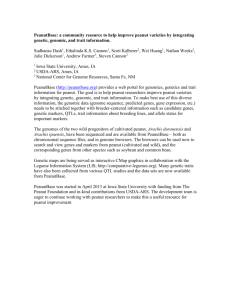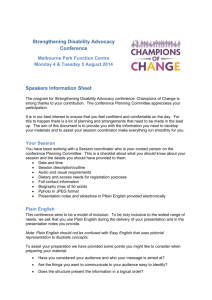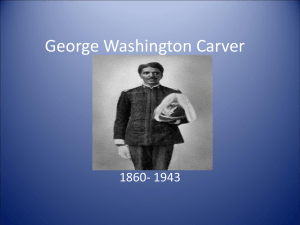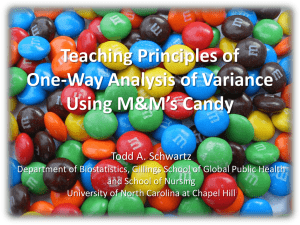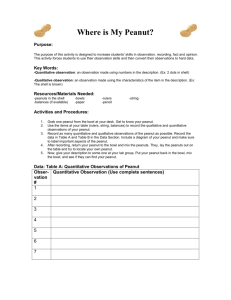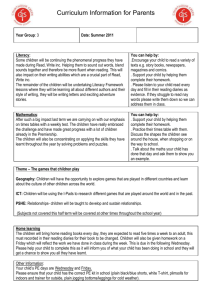What`s in there?
advertisement
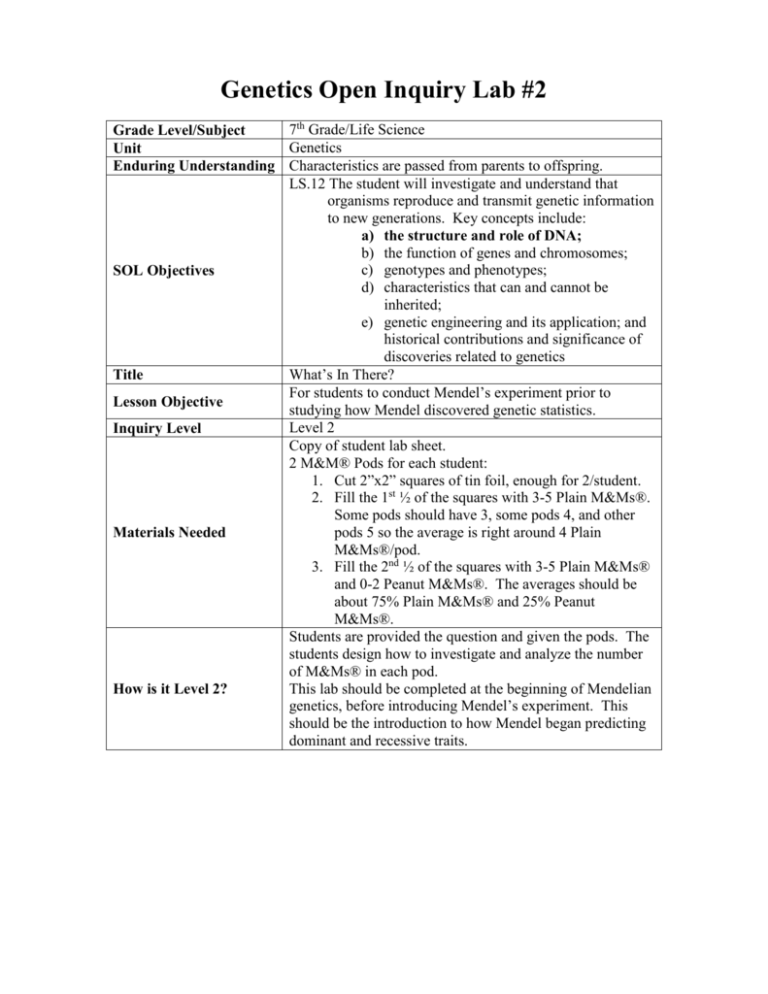
Genetics Open Inquiry Lab #2 7th Grade/Life Science Grade Level/Subject Genetics Unit Enduring Understanding Characteristics are passed from parents to offspring. LS.12 The student will investigate and understand that organisms reproduce and transmit genetic information to new generations. Key concepts include: a) the structure and role of DNA; b) the function of genes and chromosomes; c) genotypes and phenotypes; SOL Objectives d) characteristics that can and cannot be inherited; e) genetic engineering and its application; and historical contributions and significance of discoveries related to genetics What’s In There? Title For students to conduct Mendel’s experiment prior to Lesson Objective studying how Mendel discovered genetic statistics. Level 2 Inquiry Level Copy of student lab sheet. 2 M&M® Pods for each student: 1. Cut 2”x2” squares of tin foil, enough for 2/student. 2. Fill the 1st ½ of the squares with 3-5 Plain M&Ms®. Some pods should have 3, some pods 4, and other pods 5 so the average is right around 4 Plain Materials Needed M&Ms®/pod. 3. Fill the 2nd ½ of the squares with 3-5 Plain M&Ms® and 0-2 Peanut M&Ms®. The averages should be about 75% Plain M&Ms® and 25% Peanut M&Ms®. Students are provided the question and given the pods. The students design how to investigate and analyze the number of M&Ms® in each pod. This lab should be completed at the beginning of Mendelian How is it Level 2? genetics, before introducing Mendel’s experiment. This should be the introduction to how Mendel began predicting dominant and recessive traits. Name: __________________________________________________________________ What’s In There? IV:__________________________________________________________ (What are the things you are asking a question about? What have you changed in different steps of the experiment?) DV:__________________________________________________________ (What are you counting/measuring in the experiment?) Problem: ____________________________________________________ ____________________________________________________ (Write a question about which type of M&M® grows the most.) Hypothesis: __________________________________________________ __________________________________________________ __________________________________________________ (Write an “If __, then __ “ statement that answers your question.) Materials and Methods: Materials: 1 Plain M&M® Tree 1 Peanut M&M® Tree Procedures: A Plain M&M® tree was self-pollinated for many generations to create a purebred plain M&M® tree. A Peanut M&M® tree was also self-pollinated for many generations to create a purebred peanut M&M® tree. The purebred plain M&M® and purebred peanut M&M® trees were cross pollinated. The offspring were gathered to be analyzed. A second cross pollination occurred between the offspring of the original cross. The offspring were gathered to also be analyzed. Data: Directions: Look at the F1 generation. Record the results, and create an explanation for the results. Once you have the information from your group, Type your results in the computer spreadsheet to display to the class. F1 Number of M&M® in Pod 1 2 3 4 5 6 Total % Plain Peanut Directions: Look at the F2 generation. Record the results, and create an explanation for the results. Once you have the information from your group, Type your results in the computer spreadsheet to display to the class. F2 Number of M&M®’s in Pod 1 Plain Peanut 2 3 4 5 6 Total % Analysis: Respond to each of the questions with a complete sentence that describes the question in the answer. 1. What percentage of the F1 generation is plain M&M®s? What percentage of the F1 generation is peanut M&M®s? __________________________________________________________________ __________________________________________________________________ 2. What percentage of the F2 generation is plain M&M®s? What percentage of the F2 generation is peanut M&M®s? __________________________________________________________________ __________________________________________________________________ 3. How do these percentages correspond to the laws of probability? _____________ __________________________________________________________________ __________________________________________________________________ 4. What trends and patterns are emerging from the results of the two crosspollinations? _______________________________________________________ __________________________________________________________________ __________________________________________________________________ Conclusion: Answer the questions in complete sentences that include the question in the answer. 1. What was surprising about the data? Why was it surprising? __________________________________________________________________ __________________________________________________________________ __________________________________________________________________ 2. Why is it necessary to gather information from the entire class, not just the results of one group? Would the information change if results were gathered from the entire team of students? ______________________________________________ __________________________________________________________________ __________________________________________________________________ 3. What could be happening so no peanut M&M® are in the F1 generation, but then show up in the F2 ? _________________________________________________ __________________________________________________________________ __________________________________________________________________ 4. How does this experiment relate to Mendel’s pea experiment? __________________________________________________________________ __________________________________________________________________ __________________________________________________________________ Name: __________________________________________________________________ What’s In There? IV:__________________________________________________________ (What are the things you are asking a question about? What have you changed in different steps of the experiment?) DV:__________________________________________________________ (What are you counting/measuring in the experiment?) Problem: ____________________________________________________ ____________________________________________________ (Create a Problem about which type of M&M® grows the most..) Hypothesis: __________________________________________________ __________________________________________________ __________________________________________________ (Write a Hypothesis that answers your question). Materials and Methods: Materials: 1 Plain M&M® Tree 1 Peanut M&M® Tree Procedures: A Plain M&M® tree was self-pollinated for many generations to create a purebred plain M&M® tree. A Peanut M&M® tree was also self-pollinated for many generations to create a purebred peanut M&M® tree. The purebred plain M&M® and purebred peanut M&M® trees were cross pollinated. The offspring were gathered to be analyzed. A second cross pollination occurred between the offspring of the original cross. The offspring were gathered to also be analyzed. Data: Directions: Look at the F1 generation. Record the results, and create an explanation for the results. Once you have the information from your group, Type your results in the computer spreadsheet to display to the class. F1 Number of M&M® in Pod 1 2 3 4 5 6 Total % Plain Peanut Directions: Look at the F2 generation. Record the results, and create an explanation for the results. Once you have the information from your group, Type your results in the computer spreadsheet to display to the class. F2 Number of M&M®’s in Pod 1 Plain Peanut 2 3 4 5 6 Total % Analysis: Respond to each of the questions with a complete sentence that describes the question in the answer. 1. Identify the percentage of plain and peanut M&M®s in the F1 generation. __________________________________________________________________ __________________________________________________________________ 2. Identify the percentage of plain and peanut M&M®s in the F2 generation. __________________________________________________________________ __________________________________________________________________ 3. Explain how those percentages relate to the laws of probability. __________________________________________________________________ __________________________________________________________________ __________________________________________________________________ 4. Identify trends and patterns emerging from the results of the two crosspollinations. _______________________________________________________ __________________________________________________________________ __________________________________________________________________ Conclusion: Answer the questions in complete sentences and include the question in the answer. 1. Explain what was surprising about the data? Why was it surprising? __________________________________________________________________ __________________________________________________________________ __________________________________________________________________ 2. What inconsistencies may have occurred if the data was gathered from only one group? Explain how information gathered from all of the groups influenced the accuracy of the data? ________________________________________________ __________________________________________________________________ __________________________________________________________________ 3. Tell what is happening so there are no peanut M&M®s in the F1 generation, but they are present in the F2 generation. ____________________________________ __________________________________________________________________ __________________________________________________________________ 4. What can you and Gregor Mendel learn from this experiment? What is your conclusion? _______________________________________________________ __________________________________________________________________ __________________________________________________________________ __________________________________________________________________ Name: __________________________________________________________________ What’s In There? IV:__________________________________________________________ (What are the things you are asking a question about? What have you changed in different steps of the experiment?) DV:__________________________________________________________ (What are you counting/measuring in the experiment?) Problem: ____________________________________________________ ____________________________________________________ (Create a Problem about plain and peanut M&M®’s). Hypothesis: __________________________________________________ _______________________________________________________ _______________________________________________________ (Write a Hypothesis to the problem). Materials and Methods: Materials: 1 Plain M&M® Tree 1 Peanut M&M® Tree Procedures: A Plain M&M® tree was self-pollinated for many generations to create a purebred plain M&M® tree. A Peanut M&M® tree was also self-pollinated for many generations to create a purebred peanut M&M® tree. The purebred plain M&M® and purebred peanut M&M® trees were cross pollinated. The offspring were gathered to be analyzed. A second cross pollination occurred between the offspring of the original cross. The offspring were gathered to also be analyzed. Data: Directions: Look at the F1 generation. Record the results, and create an explanation for the results. Once you have the information from your group, Type your results in the computer spreadsheet to display to the class. F1 Number of M&M® in Pod 1 2 3 4 5 6 Total % Plain Peanut Directions: Look at the F2 generation. Record the results, and create an explanation for the results. Once you have the information from your group, Type your results in the computer spreadsheet to display to the class. F2 Number of M&M®’s in Pod 1 Plain Peanut 2 3 4 5 6 Total % Analysis: Respond to each of the questions with a complete sentence that describes the question in the answer. 1. Use probability to find the percentage of plain and peanut M&M®s in the F1 generation. ________________________________________________________ _________________________________________________________________ 2. Use probability to find the percentage of plain and peanut M&M®s in the F2 generation. ________________________________________________________ __________________________________________________________________ 3. Relate the percentages to the laws of probability. _________________________ __________________________________________________________________ __________________________________________________________________ 4. Identify and state a rule for the trends and patterns emerging from the results of the two cross-pollinations. ___________________________________________ __________________________________________________________________ __________________________________________________________________ Conclusion: Answer the questions in complete sentences using the question in the answer. 1. What inconsistencies occurred in the data, and create an explanation. __________________________________________________________________ __________________________________________________________________ __________________________________________________________________ 2. Compare the information gathered from one group versus the entire class and develop an explanation of why data was analyzed from all groups. __________________________________________________________________ __________________________________________________________________ __________________________________________________________________ 3. Propose and explanation of the number of peanut M&M®s in the F1 generation, but they are present in the F2 generation. __________________________________________________________________ __________________________________________________________________ __________________________________________________________________ 4. Compare this experiment to Mendel’s pea experiment. __________________________________________________________________ __________________________________________________________________ __________________________________________________________________

